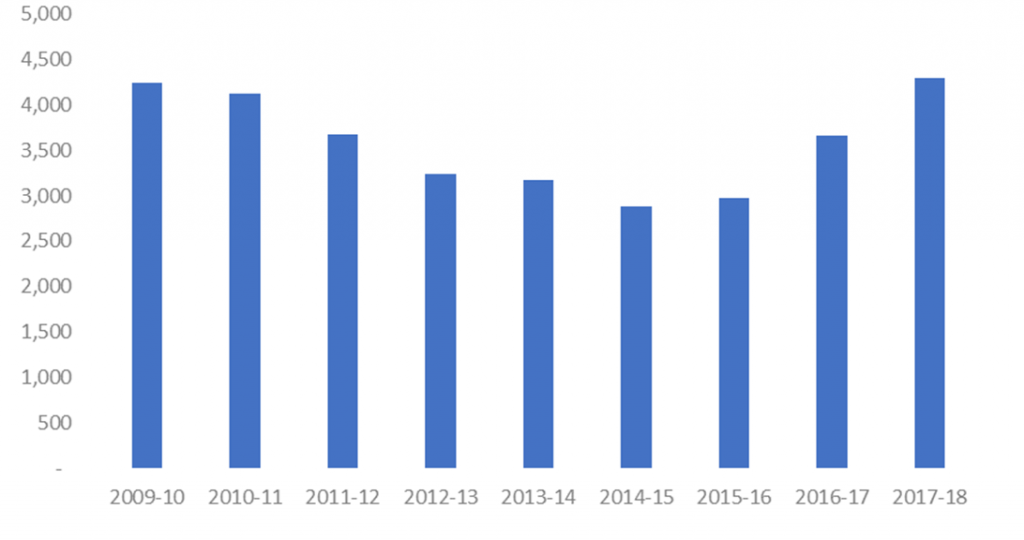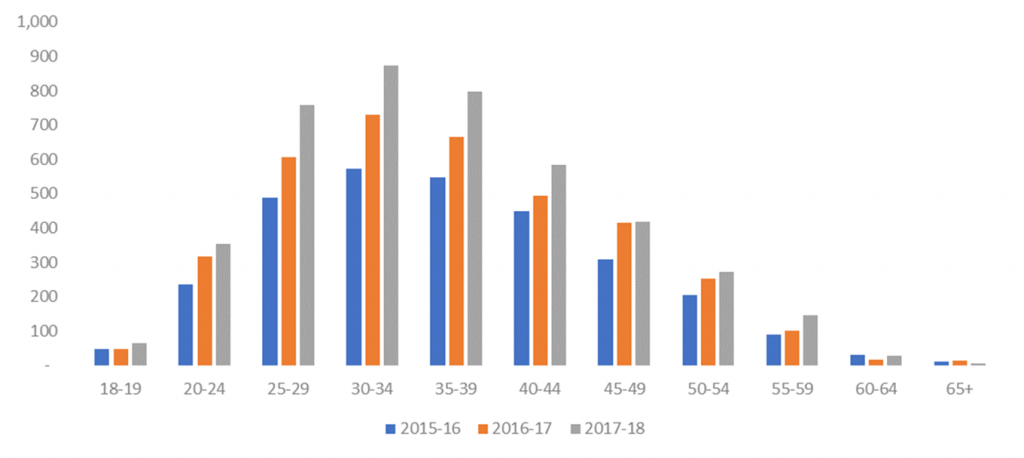
PHE’s latest prevalence estimates of opiate and crack use (OCU) show that at a national level, the combined numbers of people who take crack cocaine on its own, illicit opiates (mainly heroin) on their own and those who take both drugs, rose by 4.4% between 2014-15 and 2016-17.
We think that the overall 4.4% increase has been caused by more people using one of these drugs without the other, for example more people using crack without heroin.
This pattern is reflected in data from the National Drug Treatment Monitoring System (NDTMS) data which shows that the numbers of people coming into treatment for crack problems (without heroin) increased 49% between 2014-15 and 2017-18.
Numbers of people entering crack treatment

We can get further insight into who is using crack from the NDTMS data. The increases in people in crack treatment are in most age groups. This looks like a change to the previous trend where crack treatment was declining among younger people.
Number of people entering crack treatment by age

Crack use around the country
The OCU prevalence estimates provide a picture of opiate and crack use across England in 2016-17. Although there was no statistically significant change in crack use in any of the English regions, some areas like the East of England and the South East saw very large increases in crack use between 2011-12 and 2014-15, which stayed at this increased level in the 2016-17 estimates.
The main exception to this is London, where there was an 8% fall in estimated crack use in 2016-17. These trends seem to support the ‘county lines’ phenomenon, where drug gangs from major cities exploit drug markets in other towns and areas.
The crack investigation
We’ve been concerned about the rise in crack use for a while. As well as the previous prevalence estimates which showed a rise, and the treatment figures which backed this up, other indicators have added to this picture, showing that there’s been significant increases in cocaine production and that crack purity in England and Wales has risen substantially.
This apparent rise in crack use led to a commitment in the government’s 2018 Serious Violence Strategy to try to understand the reasons behind it. So PHE and the Home Office undertook an investigation through interviews and focus groups with drug treatment workers, service users and police officers in 6 different local authority areas in 2018.
The investigation’s findings have added to the overall picture. They confirm that there’s been an increase in crack use and, together with the existing data, suggest that rising trend began to develop several years ago, around 2013.
The investigation has also found several issues which might have led to the rise in crack use. These include the following.
Crack is more widely available now. All groups who were interviewed said that crack was more widely available than in the past, with a ready supply from dealers and fast delivery one person described as “quicker than a pizza”.
Crack is also more affordable. Interviewees thought that crack was being sold in smaller quantities than before to make it more affordable to users, although there were mixed views about whether the actual price per ‘rock’ had dropped.
Drug dealers are aggressively marketing crack. It’s being heavily pushed by dealers to existing heroin users because they’ve found that dependent crack and heroin users tend to spend more on drugs than people dependent on heroin alone.
Less stigma for using crack. Some interviewees thought that the stigma of using crack had declined in recent years, although the reason for this wasn’t clear.
A perceived lack of police focus on drugs. Some interviewees said that there were fewer police on the streets, and there appeared to be less capacity to target drug dealers or people carrying small amounts of drugs.
County lines activity. Half the areas in the investigation said that county lines was a significant issue in the rise in crack use. However, it wasn’t clear whether county lines drug dealing operations had driven the increase in crack use across the country, because use had also increased in areas where county lines operations were not common.
Implications of the prevalence figures and the crack investigation
Taken together, the recent prevalence statistics and the crack investigation show us that there has been a worrying rise in crack use in England, and it sends a warning signal to all parts of the country.
Even if the latest prevalence stats don’t show a further rise in crack use, at the very least it remains at the high level it reached in previous years and isn’t going down.
The inquiry suggests that the recent increase in crack use has been mainly among existing heroin users, but there have also been suggestions of new, more hidden group of crack users who are not heroin users and who have had no connection with treatment services.
This inquiry has also shown that treatment services need more effective ways of reaching crack users and providing treatment which meets their specific needs. We know that crack users are harder to engage in treatment than opiate users, because there is a 61% unmet need for crack (the numbers of people with crack problems against the numbers in treatment) compared to 46% for opiates.
Most crack users who are in treatment are there because they’re using heroin as well, and it’s the heroin problem that has brought them in.
All these issues point to a real need for good, well-supported local treatment systems that can respond to both the increasing numbers and specific needs of crack users. This requires local authorities to understand the levels of unmet need, which will vary substantially between different areas.
They need to have strong local partnerships that can join up the dots between treatment, prevention and the criminal justice system, to make sure that opiate and crack users, and other vulnerable people, are getting the support they need.
This agenda matters to individuals and communities. PHE will continue to keep a close eye on opiate and crack prevalence, and work with partners in government and elsewhere to monitor the issues that are arising at a local level.
We will also continue our work of supporting local authorities by providing them with bespoke data, guidance and other resources.
The information we have gathered as part of these prevalence estimates and the crack investigation will feed into Dame Carol Black’s ongoing drugs review.

1 comment
Comment by SMcArthut posted on
Why do you think this is?il tell you it’s to escape the mundane poverty stricken lives they lead,no hope for the future,and if the Government doesn’t change this it will carry on from them to their children’s children!!